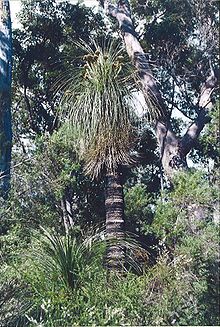Kingia australis
| Kingia | |
|---|---|
 |
|
| Kingia australis at Fernhook Falls, Western Australia | |
| Scientific classification | |
| Kingdom: | Plantae |
| Clade: | Angiosperms |
| Clade: | Monocots |
| Clade: | Commelinids |
| Order: | Arecales |
| Family: | Dasypogonaceae |
| Genus: |
Kingia R.Br. |
| Species: | K. australis |
| Binomial name | |
|
Kingia australis R.Br. |
|
Kingia is a genus consisting of a single species, Kingia australis, and belongs to the plant family Dasypogonaceae. It has a thick pseudo-trunk consisting of accumulated leaf-bases, with a cluster of long, slender leaves on top. The trunk is usually unbranched, but can branch if the growing tip is damaged. Flowers occur in egg-shaped clusters on the ends of up to 100 long curved stems. Kingia grows extremely slowly, the trunk increasing in height by about 1½ centimetres per year. It can live for centuries, however, so can attain a substantial height; 400-year-old plants with a height of six metres are not unusual.
When not flowering, Kingia australis bear a superficial similarity to species of the genus Xanthorrhoea, some of which bear the common name "blackboy" because of their purported similarity to an Aboriginal boy holding an upright spear. However, the flower stalks of Kingia australis are completely different from that of Xanthorrhoea species. Because of this, Kingia australis was for many years thought to be a female form of the blackboy and was commonly named black gin, a derogatory term for an Aboriginal woman*. This remains a widely known common name, but is considered inappropriate and belonging to the past. The genus name Kingia or the Aboriginal name bullanock are now preferred.
Kingia and Xanthorrhoea are biologically quite distinct and are not closely related. For example, Xanthorrhoea have a secondary thickening meristem in the trunk (Dracaenoid secondary thickening meristem), whereas Kingia lack this feature.
Specimens of Kingia australis were first collected by Robert Brown at King George Sound in 1801. The plant featured in the drawing View of the south side of King George's Sound by expedition artist William Westall, which was later published as a plate in Matthew Flinders' 1810 A Voyage to Terra Australis; this is the first known image of the plant. A Voyage to Terra Australia also contained the first textual reference to this species: in the botanical index, Brown writes:
...
Wikipedia
